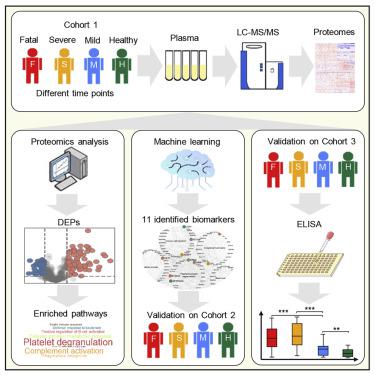Immunity ( IF 25.5 ) Pub Date : 2020-10-20 , DOI: 10.1016/j.immuni.2020.10.008 Ting Shu 1 , Wanshan Ning 2 , Di Wu 3 , Jiqian Xu 4 , Qiangqiang Han 5 , Muhan Huang 3 , Xiaojing Zou 4 , Qingyu Yang 1 , Yang Yuan 6 , Yuanyuan Bie 7 , Shangwen Pan 4 , Jingfang Mu 3 , Yang Han 1 , Xiaobo Yang 4 , Hong Zhou 6 , Ruiting Li 4 , Yujie Ren 3 , Xi Chen 5 , Shanglong Yao 8 , Yang Qiu 9 , Ding-Yu Zhang 10 , Yu Xue 2 , You Shang 11 , Xi Zhou 9

|
The coronavirus disease 2019 (COVID-19) pandemic is a global public health crisis. However, little is known about the pathogenesis and biomarkers of COVID-19. Here, we profiled host responses to COVID-19 by performing plasma proteomics of a cohort of COVID-19 patients, including non-survivors and survivors recovered from mild or severe symptoms, and uncovered numerous COVID-19-associated alterations of plasma proteins. We developed a machine-learning-based pipeline to identify 11 proteins as biomarkers and a set of biomarker combinations, which were validated by an independent cohort and accurately distinguished and predicted COVID-19 outcomes. Some of the biomarkers were further validated by enzyme-linked immunosorbent assay (ELISA) using a larger cohort. These markedly altered proteins, including the biomarkers, mediate pathophysiological pathways, such as immune or inflammatory responses, platelet degranulation and coagulation, and metabolism, that likely contribute to the pathogenesis. Our findings provide valuable knowledge about COVID-19 biomarkers and shed light on the pathogenesis and potential therapeutic targets of COVID-19.
中文翻译:

血浆蛋白质组学识别 COVID-19 的生物标志物和发病机制
2019 年冠状病毒病 (COVID-19) 大流行是一场全球公共卫生危机。然而,人们对 COVID-19 的发病机制和生物标志物知之甚少。在这里,我们通过对一组 COVID-19 患者(包括非幸存者和从轻度或严重症状中恢复的幸存者)进行血浆蛋白质组学来分析宿主对 COVID-19 的反应,并发现了许多与 COVID-19 相关的血浆蛋白变化。我们开发了一个基于机器学习的管道,用于识别 11 种蛋白质作为生物标志物和一组生物标志物组合,这些组合经过独立队列的验证,并准确地区分和预测了 COVID-19 的结果。一些生物标志物通过酶联免疫吸附测定 (ELISA) 使用更大的队列进行了进一步验证。这些显着改变的蛋白质,包括生物标志物,介导病理生理学途径,例如免疫或炎症反应、血小板脱粒和凝血以及代谢,可能有助于发病机制。我们的研究结果提供了有关 COVID-19 生物标志物的宝贵知识,并揭示了 COVID-19 的发病机制和潜在治疗靶点。









































 京公网安备 11010802027423号
京公网安备 11010802027423号